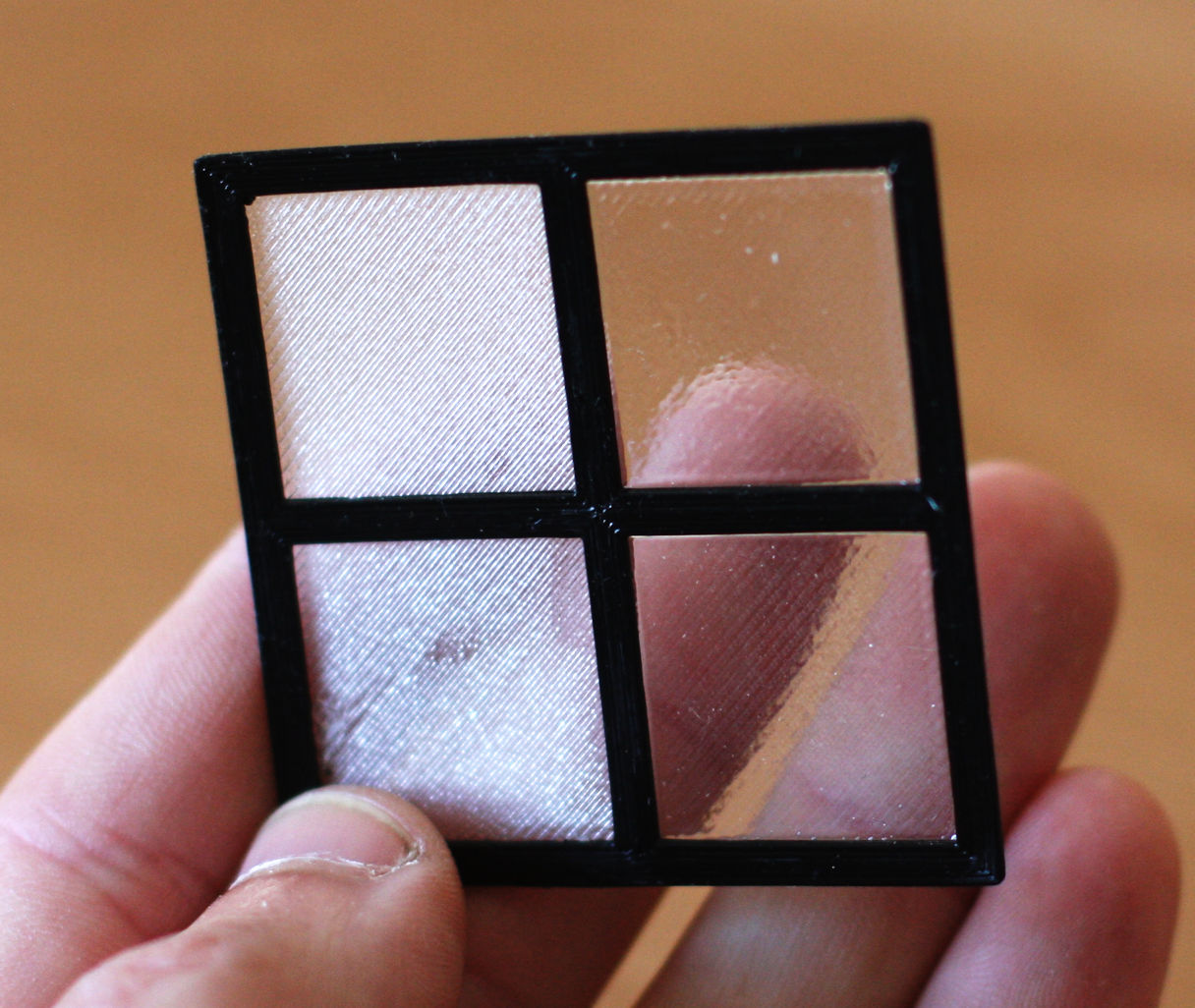
Transparent Window Printing: PETG-/PVB-Composite (Proof of Concept)
prusaprinters
<h3>Introduction</h3><p>Many designs like RC cars and trucks, lanterns, model houses, etc. would benefit if 3D printing could be used to create truly transparent window panes. But as you might know, FDM printing transparent filament per se does not result in transparent prints. Tiny gaps in the print will make the result appear opaque and rather white-shimmering:</p><figure class="image image_resized" style="width:38.06%;"><img src="https://media.prusaprinters.org/media/prints/69331/rich_content/94ccef47-9fd5-4cb5-b371-c101949e09fc/clear1.jpg#%7B%22uuid%22%3A%22c552a846-52d5-4eb3-ba68-643fd7379c2f%22%2C%22w%22%3A1017%2C%22h%22%3A858%7D"></figure><p>The more layers there are, the more opaque the result becomes. But even with only one layer - and even with using spiral vase mode - the print will not be as transparent as you might wish:</p><figure class="image image_resized" style="width:34.33%;"><img src="https://media.prusaprinters.org/media/prints/69331/rich_content/3277d07c-75cf-40f7-a0d5-b2b66f34db90/clear2.jpg#%7B%22uuid%22%3A%2203f87fd8-4e6d-4a30-9577-08818d3df49d%22%2C%22w%22%3A1017%2C%22h%22%3A858%7D"></figure><p>Now <a href="https://blog.prusaprinters.org/prusament-pvb-our-new-transparent-filament-made-for-easy-chemical-smoothing_43066/">PVB</a> filament offers the option to get transparent designs my using IPA-smoothing. I was wondering, why after about half a year I still do not see a significant number of designs out there that make use of this technique. I guess it is because smoothing PVB is not as easy as it seems. By experimenting with PVB-smooting in some of my other projects (e.g. raingauge and hourglass) I got a fair bit of experience in this field. So in my opinion the main problem is stability of the design during the smoothing process: IPA will soften the PVB, so it will not only become very sticky - which makes it hard to handle - but also will most likely harm the structure, so that the part will warp and loose its shape.</p><p>To overcome those problems I came up with the idea to use composite printing: When connecting PVB to a material that is not affected by IPA, the other material then can act as a support structure. This support then ensures the design will keep it shape when smoothing. Also you have something to hold the part during smooting.</p><h3>Composite printing</h3><p>Composite printing two different materials is as easy as multi-color printing by changing filements during print at a certain height:</p><figure class="image"><img src="https://media.prusaprinters.org/media/prints/69331/rich_content/a0bebe89-b0b0-4945-a63c-c3658ca0b6d4/printing.png#%7B%22uuid%22%3A%22956596e4-4cb2-4028-a5da-0c3bcb81fffb%22%2C%22w%22%3A638%2C%22h%22%3A411%7D"></figure><p>I did have very good results using this technique for printing TPU onto PETG. But with PVB the choice of an accompanying material is not as easy: PLA and PVB for example just do not stick to each other at all (at least this was my experience with ultra-silk PLA). PETG and PVB do stick to each other a bit better, but still they do delaminate quite easily. Fortunately after smoothing, the dissolved PVB acts as a kind of glue that improves the bond between the two materials to a certain degree, where I gues it will work for most situations.</p><h3>Composite Printing PVB and PETG</h3><p>In the downloads of this project there are design- and print-files where I printed one single layer (0.2mm) of PVB and then a few layers of PETG on top. Since PVB can be printed with 230°C, I did not bother with changing the print temperature for the filament change. Instead I printed all of it using PETG settings. For producing durable parts I highly recommend to as a temperature change to print all materials at the temperature that is appropriate.</p><h3>IPA-Smooting PVB</h3><p>After printing I did apply IPA onto PVB using a brush. I soaked both sides well in IPA and spread the material with the brush. I repeated this step about 5 times and let the part dry for several hours each time. Here is the result (No IPA-smoothing on the left side for comparison):</p><figure class="image"><img src="https://media.prusaprinters.org/media/prints/69331/rich_content/6b56fe72-5755-4eeb-a121-43dcfd6ee5d1/window.jpg#%7B%22uuid%22%3A%221c5611f8-8536-4012-8be9-673db7562468%22%2C%22w%22%3A1216%2C%22h%22%3A1026%7D"></figure><p>The PVB has become transparent quite well - at least it is much better than any other transparent print I have seen so far. By continuing smoothing for a couple more times, the remaining layer line artifacts should completely vanish. A bit of over-extrusion might help, too.</p><p>If you look from the other side, you can perhaps guess that the smoothed PVB acts as some kind of glue and thus has connected the two layers better to each other:</p><figure class="image"><img src="https://media.prusaprinters.org/media/prints/69331/rich_content/0c04f09c-62bf-4448-84f8-b589a8bba402/underside.jpg#%7B%22uuid%22%3A%22e8aaedf0-a92c-4fcd-a19e-61b0bbb5d994%22%2C%22w%22%3A1216%2C%22h%22%3A1026%7D"></figure><p>Now all you have to do is wait some days (maybe a few weeks) until the IPA vanishes and the PVB becomes hard again.</p><h3>Conclusion</h3><p>In my opinion this proof of concept shows that it is both possible and quite easily print much better transparent parts for creating a variety of beautifull designs with PVB, that have not been possible with oridinary transparent filements yet. All you need is PVB, IPA, a brush and a bit of time and patience to wait for IPA to vanish after smoothing.</p><h3>Prospects</h3><p>I am now looking forward for the new version 2.4 of the PrusaSlicer to be released, because I have heard that you then can do ironing on all layers, which might help to get a better print to start smooting from. Also I am keen on seeing if anybody takes this technique and uses it on his or her own design (Please leave a note on the comments!).</p><h3><strong>Design and Source Code</strong></h3><p>The design has been implemented in OpenSCAD (the source code is provided for download).</p><h3><strong>Happy printing!</strong></h3><p>If you like this design, then <strong>please leave a like</strong> and also <strong>post a comment</strong>.to tell me your opinion and ideas about PVB smoothing and transparent prints. Also check out my <a href="https://www.prusaprinters.org/social/52356-mageb/prints"><strong>other designs</strong></a>.</p><p>The following designs also deal with the subject of PVB-smoothing:</p><figure class="table" style="height:466.903px;width:714.02px;"><table style="background-color:rgb(255, 255, 255);border-bottom:1px double rgb(179, 179, 179);border-left:1px double rgb(179, 179, 179);border-right:1px double rgb(179, 179, 179);border-top:1px double rgb(179, 179, 179);"><tbody><tr><td style="border-bottom:1px solid rgb(191, 191, 191);border-left:1px solid rgb(191, 191, 191);border-right:1px solid rgb(191, 191, 191);border-top:1px solid rgb(191, 191, 191);padding:0.4em;vertical-align:top;width:50%;"><p><a href="https://www.prusaprinters.org/prints/69196-hourglass"><strong>Hourglass</strong></a><strong>:</strong></p><figure class="image image_resized" style="width:100%;"><img src="https://media.prusaprinters.org/media/prints/69331/rich_content/87cb6a02-9569-4039-8ef7-ba24aab4270a/overview.jpg#%7B%22uuid%22%3A%2238f53f20-3c82-468d-b20a-ff0bb72826d5%22%2C%22w%22%3A1815%2C%22h%22%3A1531%7D"></figure></td><td style="border-bottom:1px solid rgb(191, 191, 191);border-left:1px solid rgb(191, 191, 191);border-right:1px solid rgb(191, 191, 191);border-top:1px solid rgb(191, 191, 191);padding:0.4em;vertical-align:top;"><p><a href="https://www.prusaprinters.org/prints/60395-rain-gauge-using-advanced-techniques-and-pvb"><strong>PVB Rain Gauge</strong></a><strong>:</strong></p><figure class="image image_resized" style="width:73.3%;"><img src="https://media.prusaprinters.org/media/prints/68338/rich_content/a84aebb5-6e5c-48a8-a4c1-f9bb5ec8a5e4/thumbs/cover/800x921/jpg/raingauge3.webp"></figure></td></tr></tbody></table></figure>
With this file you will be able to print Transparent Window Printing: PETG-/PVB-Composite (Proof of Concept) with your 3D printer. Click on the button and save the file on your computer to work, edit or customize your design. You can also find more 3D designs for printers on Transparent Window Printing: PETG-/PVB-Composite (Proof of Concept).
